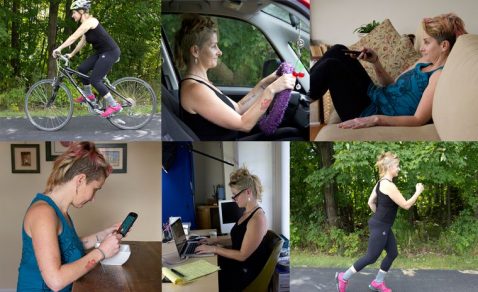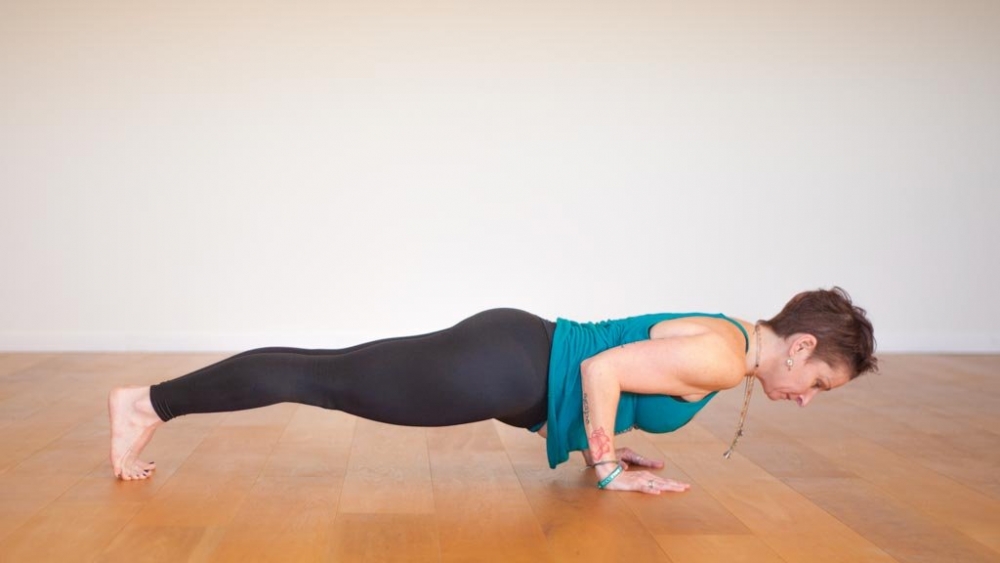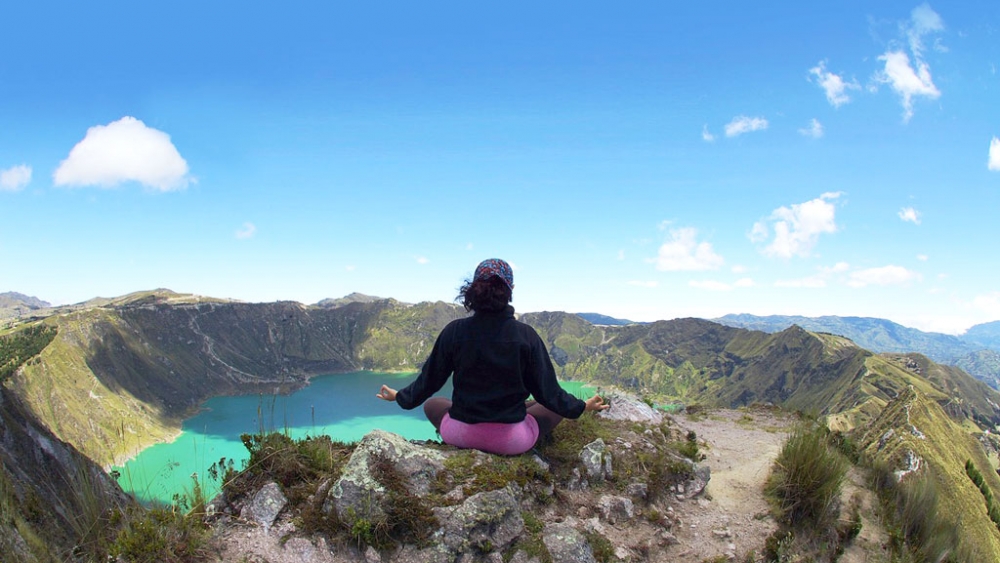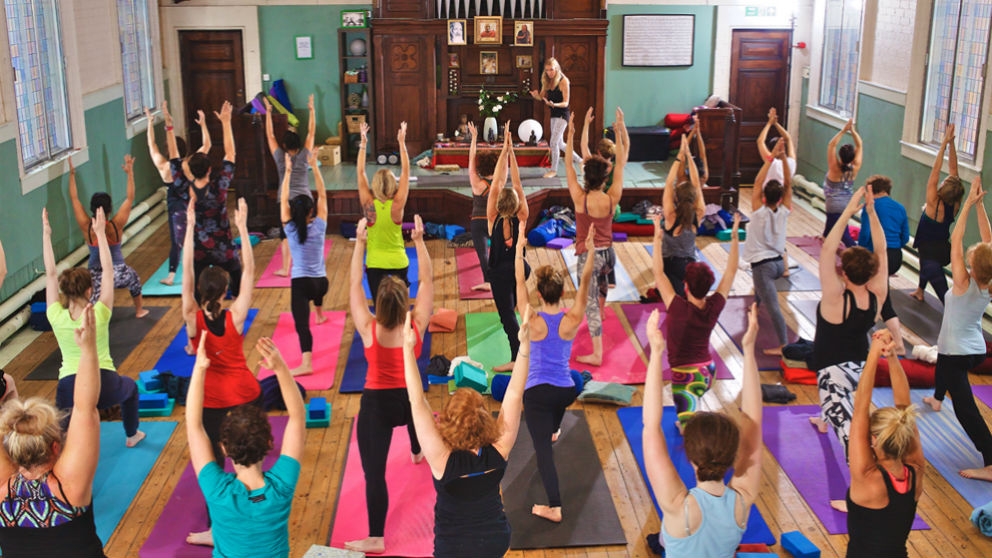You’ve probably, at some point, been instructed to Stack your knee over your ankle in Warrior 2or Align your shoulders over your wrists in Plank pose. Recently there has been much discussion in the yoga world about whether or not yoga teachers should give so many anatomical alignment cues like these.
As a passionate SAFE YOGA enthusiast and a 6-year veteran anatomy teacher of yoga teachers-in-training, my reply is a loud and resounding “YES” to extensive and intelligent alignment cues. Here are five of my reasons why:
1 FEEL ME, TOUCH ME, HEAL ME: Simple body awareness
When I was asked recently in an interview why I think people should practice Hatha yoga, my answer was: “Yoga allows you to have the holistic experience of your body and where it is situated, at any moment, in space and time…essentially the fantastic experience of being completely embodied, of feeling tremendously ALIVE.”
The majority of students coming to practice yoga for the first time are hardly aware of their body as a whole. Most people experience themselves as parts…fragmented.
The majority of students coming to practice yoga for the first time are hardly aware of their body as a whole. Most people experience themselves as parts…fragmented.
Life has a way of doing this to us: throwing us curve ball after curve ball (work, worries, traumas) and then desensitizing us from the issues that have accumulated in our tissues. I tell my teachers-in-training all the time that one of our many important jobs as yoga teachers is to put “Humpty Dumpty” back together again so he or she can go back into their lives and do whatever it is that they do (for work or play) all over again…with zest, vitality, and incredible sense of feeling complete.
Alignment cues encourage people to focus their minds on a particular body part, the cues teach them how to move it (within their own range of motion), place it and breathe into it, how to feel it if it is tight, tense or restricted in some way. This then opens the student up to the deeper awareness of their body and the myriad of possibilities (and realities) of less pain and discomfort and more freedom, ease and range of movement (where perhaps they were even unaware there was none).
2 WHO ARE YOU? Awakening to one’s physical habitual patterns

Whether it be from sitting at a desk all day, driving a car for a job, training for a marathon or bicycle race or sleeping on your belly with your head turned to the right for 30 years – habitual patterns have been set up in your body that will adversely affect (weaken) the body as a whole.
Whether it be from ‘automatic’ movements imprinted over a lifetime, accidents, emotional traumas or significant life events, unhelpful habitual movement patterns will adversely affect (weaken) the body as a whole.
Also, residue from accidents, emotional traumas or big life events like growing, birthing and carrying a baby on your hip will set up habitual patterns in the body that are not beneficial to the body’s continuous attempts to attain dynamic equilibrium (natural state of harmony, balance and radiant health).
The human body is made up of about 300 joints and each joint has a certain amount of natural movements performed by specific agonist (primary mover) and synergist (helper) skeletal muscles. In order for the body to be radiantly healthy and perform at its optimum levels efficiently, all connective tissue (bones, ligaments, muscles, tendons and fascia) need to fully experience the balance of strength and suppleness – not too tight, tense or restricted in one area and loose or weak in another.
Teachers who teach bone alignment also need to teach proper muscle activation – educating their students on what skeletal muscles move and place the bones in certain shapes (poses and counterposes). This is so important for both on- and off-the-mat longevity; if we have the knowledge and the experience of how to properly move the body we will be less susceptible to soft tissue wear and tear and the risk of injuries will be diminished.
3 GRAVITY: Always a factor
As we consistently and continuously practice the many different styles of Hatha yoga, working to experience the body-breath-mind union, we will inevitably get stronger, more supple, more able to experience sensations of whole body vibrancy and buoyancy. Until then we usually land on the mat experiencing the opposite: heaviness, stiffness, with a body that seems fragmented (experiencing the individual parts versus the brilliant sum whole).
Sometimes I think us older, wiser (wink, wink) and seasoned yoga teachers forget what it felt to be a new yoga practitioner: confused, uncoordinated, clumsy, weak, unable to float, fly or even balance! My boyfriend, Dan, came up with a great analogy for this:
If you sent a bunch of seasoned/master yoga teachers (all asanas performed with ease, pranayama techniques mastered, bandhas perfectly engaged, meditative minds completely and utterly focused on their drishtis) on a field trip to a planet where gravity is much different to ours here on earth (as if the air was like the consistency of honey) and asked them to practice yoga like they do back home…they will inevitably look at each other and ask HOW do we navigate these bodies? Where are the inhabitants of this planet…can they teach us how to move and place our bodies in such a way we won’t get hurt?
I loved this analogy of his! What would it feel like to be a beginner again…to be taught how to move your body in a way that defies the constraints gravity puts upon it?
What would it feel like to be a beginner again…to be taught how to move your body in a way that defies the constraints gravity puts upon it?

We all have had the experience (and if you are reading this and it hasn’t happened yet…IT WILL!) of a posture that we struggled, sweated and swore through, that with diligent practice, became incredibly effortless and graceful. Alignment-based yoga teachers are teaching general bone-stacking and muscle activation guidelines (not all placements work for all body types, of course) in order that the student can find this ease, the free-flow of pranic energy that is so Sukha sweet!
4 SAFE YOGA ROCKS: Ligaments are not elastic
Wrong placement – going against the natural working order of the bones and joints – of one’s body parts can place possible injurious stress on the surrounding connective tissue – especially when gravity is a factor! A fact to remember: ligaments are not elastic! Once stretched from their original shape they will never go back to their original shape. Because of this, it is not beneficial to the ligaments to “hang” on your bones in a stretch – again, especially when gravity is a factor.
Once stretched from their original shape ligaments will never go back to their original shape. Because of this it is not beneficial to the ligaments to “hang” on your bones in a stretch.
For example, in a posture with a higher centre of gravity such as Warrior 1 or 2, the knee ought not to go beyond the stacked ankle/heel. Otherwise, the amount of pressure that the thigh bone places on the kneecap tendon and the knee joint ligaments can lead to injury – both from repetitive motion and traumatic. A lower centre of gravity pose such as Low lunge doesn’t necessarily have the same amount of force on the knee. Although some knees, even in such a low posture, should also not traverse beyond the ankle/heel.

Another example is to make sure your shoulders do not dip below your elbows in Chaturanga Dandasana. This puts unnecessary (and injurious) weight on the ligaments, tendons and bursas of the shoulder girdle and the elbow. Also, be aware of keeping the ribs in line with the parallel-to-the-earth upper arm bones in this low plank posture. By not allowing the ribs to dip lower you prevent any unnecessary load-bearing stress on the ligaments of the sternoclavicular and acromioclavicular joints.
For lots more on this read For the love of the shoulder and Our complicated shoulders and Chaturanga Dandasana
It is ok, however, to have the shoulders lower than the elbows as you rest on the floor and before you use your back muscles to peel your body off the mat in Bhujangasana (Cobra Pose) because your orientation to gravity is low (lying down on the ground) and you’re using your erector spinae muscles (back extensors) to lift your body off the mat.
Up to this point all these examples I have mentioned have been ones I have witnessed countless other yoga practitioners struggle with pain, discomfort and injury in.
A last example is one I have personally experienced. I am a hyper-extender of the knees; with no muscle activity I have “fallen” into the back of my knees since I was a youngster. Well, this quality of mine was celebrated in a specific type of hot yoga I have been lovingly practicing since 1999 where a repetitive cue is to “lock your knees, lock your knees, lock your knees”. Easy for a hyper-extender such as myself to do…every class, six days a week for two years straight I locked my knee in six standing poses (higher center of gravity, termed weight bearing and four of them being on one leg only). Unfortunately, the ligament damage in my knees is so extensive that sometimes I stumble when I walk because I am so unstable there. Now, when I practice that form of yoga (I still love and appreciate the set sequence) I micro-bend my knee to protect this precious joint – an important safety alignment cue not usually offered but is crucial for the health of the ligaments of the knee!
5 BE HERE NOW: Atha Yoga Anushasanam

Lastly, one of the most yogic reasons for teaching and practicing alignment-based yoga: UTMOST PRESENCE IN THE SACRED NOW. One of the most profound utterances besides AUM is the sanskrit work ATHA which means NOW. Yoga means union and one of the many translations of this concept of unity is the body-mind-breath-spirit connection that really can only be possible RIGHT NOW. This moment. HERE. NOW. Are you here? Where are you? Are you planning or worrying about the future? Are you feeling resentment or guilt about what happened in the past? Are you here being, breathing, experiencing the magic that is continuously unfolding or are you…oops, you just missed it. Now, here it is again. Be here now…and now…and now…
Are you here? Where are you? Are you here being, breathing, experiencing the magic that is continuously unfolding or are you…oops, you just missed it.
Are you here? Where are you? Are you here being, breathing, experiencing the magic that is continuously unfolding or are you…oops, you just missed it.
Teachers that continuously teach their students how to align their bodies in such a way that the most Sthira (stability) and Sukha (comfort) will be experienced are offering their students something to focus their minds on. For 60, 75 or 90 minutes the student’s mind is listening to the teacher, listening to their body’s strengths and weaknesses, listening to their breath to find both blockages and freedom. During this time there are no worries about the kids, the bills, the boss, the aging and ailing parents, etc. In essence, alignment based classes are meditations into the now, where the body actually moves, transforms and rests. The mind loves to abandon the body…alignment based yoga offers the student a way to the body, a back to the NOW.

